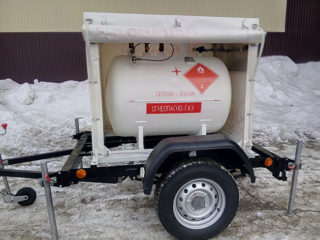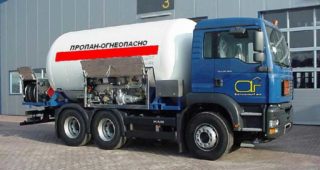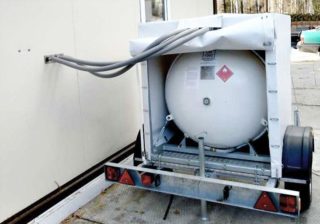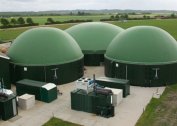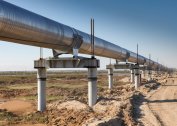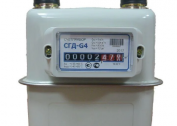A special tank is designed to contain liquefied gas, for example, a mixture of propane and butane or methane. A mobile gas tank is used for autonomous fuel delivery and boiler supply in homes, cottages, and on construction sites. The design is a container or a set of cylinders mounted on a frame (trailer) with wheels. Installation is easy to use, mobile and easy to refuel.
Design features of a mobile gas tank
Stationary tanks are dug into the ground at the site, but the transported gas tank is the most requested reservoir. 4 cylinders of 50 liters are used. However, it is better to provide for the design of 3 sealed containers of 200 liters. Such tanks allow less frequent refueling.
The design includes elements:
- standard trailer for a car or a frame welded from metal on wheels;
- gas cylinders;
- valves for gas;
- insulation layer (for winter), for example, foil polystyrene foam;
- corrugated and simple hoses, studs, fittings, rubber tubes.
The legislation allows the transport of no more than 15 pieces of cylinders with a capacity of 50 liters per car. The volume is equal to 750 liters of gas, so mobile units with a volume of 600 liters are popular.
The principle of operation of the installation
Refuel the gas tank at gas stations or from a car tank using a standard gun. The stock is replenished when 18 to 20% of the fuel remains in the storage. Liquefied gases are used in a mixture, as the composition of butane and propane responds differently to an increase in temperature.
The summer version provides the same ratio of species, and in winter, a composition with a propane content of more than 90% is used. Butane almost does not evaporate in the cold; volatile propane is used. After evaporation of the last species, it is necessary to pump out the remaining gas, but more often they refuel with the next portion.
If this is done regularly, soon the container will be filled only with butane and the use of a gas holder will be difficult. It will require pumping out unnecessary mass, which will entail an increase in costs. In a certain season, you need to pump an effective mixture in order to increase the efficiency of the gas tank, the temperature of which is in the range from -40 ° to + 45 ° C.
Registration and Safe Use Issues
 A gas holder on a trailer is simpler to draw than a stationary model. Permission from the gas company is not necessary, but a trailer is registered with the traffic police. Registration takes place as part of the standard procedure. If the installation is used by a legal entity, the equipment is registered with Rostekhnadzor.
A gas holder on a trailer is simpler to draw than a stationary model. Permission from the gas company is not necessary, but a trailer is registered with the traffic police. Registration takes place as part of the standard procedure. If the installation is used by a legal entity, the equipment is registered with Rostekhnadzor.
The purchaser checks the documents upon purchase:
- certificate of quality;
- technical data sheet of the installation;
- instruction manual.
If there is no certificate and passport, registration may be refused. A simplified registration procedure does not detract from the increased design hazard. You can avoid trouble by calling a gas specialist to connect a mobile gas tank on a trailer.
The installation is connected simply thanks to the universal detachable contacts. Connections prevent gas leakage and leakage into the air. The distance from the feed object is regulated by the length of the pipe. The gas holder is protected from the sun and rain.
Mounting Features
The gas holder is covered with a tent made of polyvinyl chloride, the material withstands cold, heat, does not get wet from precipitation. The insulated gas tank needs to be heated in the winter to increase the effectiveness of the work.
Heating options:
- the gas tank system is connected to the heating circuit to ensure the correct evaporation temperature;
- another option involves the connection of an autonomous boiler room;
- There are modern models of heating using carbon fiber film and electricity.
For automatic shutdown, a coordinating module is installed so as not to overheat to a dangerous level. If the internal pressure in the tank reaches its maximum value (greater than 500 kPa), a fuse will be activated. Control and locking equipment eliminates the possibility of an accident. The mobile gas tank is connected to the consuming equipment by corrugated hoses with detachable contacts.
Placement requirements
The trailer with full cylinders cannot be placed in the garage or shed, it is recommended to arrange a ventilated place on the street for parking. Durable galvanized tanks or gas cylinders are securely mounted on the trailer frame to prevent movement during movement. Outriggers are used - stops, which are placed in 4 pieces.
It is allowed to place a propane or methane gas tank at a minimum distance from the house - to place it directly at the vertical fence. This norm is regulated in SP 63.13330 - 2011. Remoteness from other structures and structures is not regulated.
Control devices and the panel are placed so that they are not accessible to children or strangers. The vehicle is easy to steal, therefore appropriate protection is provided.
Advantages and disadvantages of a mobile gas tank
 Cylinders are always assembled in a set, they are easy to bring to a gas station, do not need to be transported and loaded, you only need to connect them to the gun one at a time. There is enough fuel for heating the house for two weeks, even in winter. If a gas main is brought to the site, it is easy to sell a methane or propane gas tank and recoup the old costs.
Cylinders are always assembled in a set, they are easy to bring to a gas station, do not need to be transported and loaded, you only need to connect them to the gun one at a time. There is enough fuel for heating the house for two weeks, even in winter. If a gas main is brought to the site, it is easy to sell a methane or propane gas tank and recoup the old costs.
Other advantages of installing on wheels:
- sometimes a mobile device is not used in one place, but is transported for work to other objects;
- the capacity is a decent amount (up to 750 liters);
- the standard gas tank on wheels is easy to connect with your own hands;
- It is possible to choose the method of refueling;
- the control panel reflects operating parameters, indicators and sensors.
The disadvantages include the need for heating and the high cost of equipment.
Browse Popular Models
Gas holders with constant and variable internal volume are produced. The first type has rigid and durable walls, the thickness of which is not less than 12 mm, the design withstands high pressure. Variable volume units are equipped with a drop cover. The upper part is a water dome or piston of considerable size.
The gas holder of methane and propane differ in spatial position. Cylindrical tanks are placed horizontally or vertically. In the second case, the capacity takes up less space, but the evaporation area decreases, which leads to some decrease in the supply efficiency.
Trailer Models
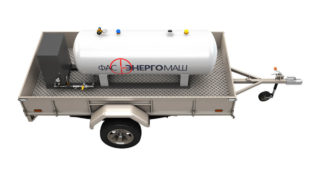 The brand Tosto serbatoi Italian manufacturer presents Amico brand plastic vessels. Thick walls withstand 1 ton per m2. The material is protected against corrosion during precipitation and wet weather. The set includes shut-off valves, safety sensors.
The brand Tosto serbatoi Italian manufacturer presents Amico brand plastic vessels. Thick walls withstand 1 ton per m2. The material is protected against corrosion during precipitation and wet weather. The set includes shut-off valves, safety sensors.
The brand remains popular City gas Bulgarian manufacturers. The body is made in the shape of a cylinder and has three welds. The company produces not only mobile, but also underground models. The outer surface is painted with polymers based on epoxy resin. The manufacturer guarantees 30 years of operation without breakdowns and reduced quality.
Famous brand Fas produced by our manufacturer "FasHimMash." The exterior of the tank is processed using airless hot spray technology, which prevents wall damage. Control detectors, angle valves, mechanical levels and pressure gauges are included.
600 liter models
Czech manufacturer introduces famous brand Vpsin which the line is represented by horizontal containers. The catalog offers volume options from 600 to 10 thousand liters, which is enough to heat a private house.
German company Deltagaz It has been producing gas tanks for about 20 years, so it has gained a lot of experience. The lineup contains models from 400 to 10 thousand liters. The product is distinguished by the yellow color of the tank and is in deserved demand.
Czech product Kadatec also has a high rating. The tanks are accompanied by certificates for use in residential buildings and in summer cottages. The production test is carried out at 25 bar pressure, it is considered safe to work at 15 bar. The volume of mobile, stationary and underground tanks varies from 500 to 100 thousand liters.
